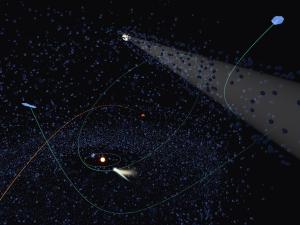Blog
Out of This World
20 January 2020
 NAOJ
NAOJWhen Oumuamua was discovered in 2017, it was the first object known originate beyond the solar system. The evidence of its extrasolar origin was pretty clear. Its orbit was tilted far from the plane of the solar system, and it was moving so quickly that the Sun’s gravity could not hold it in a closed orbit. Oumuamua is currently on its way out of the solar system. It will leave and never return.
Oumuamua’s type of orbit is known as a hyperbolic orbit. It is different from the elliptical orbits of the planets and most solar system bodies. While Oumuamua’s orbit is particularly unusual, it isn’t the only body known to have a hyperbolic orbit. Numerous comets do as well, and like Oumuamua, they can have highly inclined orbits. So are these comets of alien origin as well?
Recently a team of astronomers looked at this exact question.1 They looked at the hyperbolic orbits of comets and calculated how likely one is to be of interstellar origin.
Comets are thought to come from a halo of icy bodies on the outer edge of the solar system, known as the Oort cloud. When some gravitational interaction disturbs them, they can fall toward the inner solar system, becoming a long-period comet.
If the gravitational interaction is just right, a comet could have enough energy to escape the solar system. In this case, the comet could swing through the inner solar system once, and then escape the solar system forever. These comets would look quite similar to an interstellar body that happened to drift through our solar system.
In many cases, it could be difficult to distinguish a stellar comet with a hyperbolic orbit from an interstellar one. So the team took a statistical approach. By modeling the orbits of hyperbolic trajectories, they found the odds of being interstellar depends on two orbital properties. The first is the perihelion distance, or how close the object comes to the Sun. The second is the orbit eccentricity. This measures how “squashed” an orbit is. A circular orbit has an eccentricity of 0, and the larger the eccentricity the more elliptical or “squashed” the orbit is. They found that the smaller the perihelion distance and the greater the eccentricity, the more likely it is to be interstellar.
In other words, interstellar bodies not only have hyperbolic orbits, they are also likely to pass close to the Sun, and have paths that are nearly straight as they head into and out of the solar system. Oumuamua meets this condition very well, meaning it is almost certainly of interstellar origin. The comet Borisov, discovered in 2019, also meets this criterion, making it the second known interstellar body.
Interstellar bodies are likely to visit our solar system on a fairly regular basis. Humans have likely spotted many of them throughout history, thinking they were a part of our solar system. Having discovered two interstellar visitors, it is only a matter of time before we discover many more.
Higuchi, Arika, and Eiichiro Kokubo. “Hyperbolic orbits in the Solar system: interstellar origin or perturbed Oort cloud comets?.” Monthly Notices of the Royal Astronomical Society 492.1 (2019): 268-275. ↩︎